A Time of Magic and Wishes
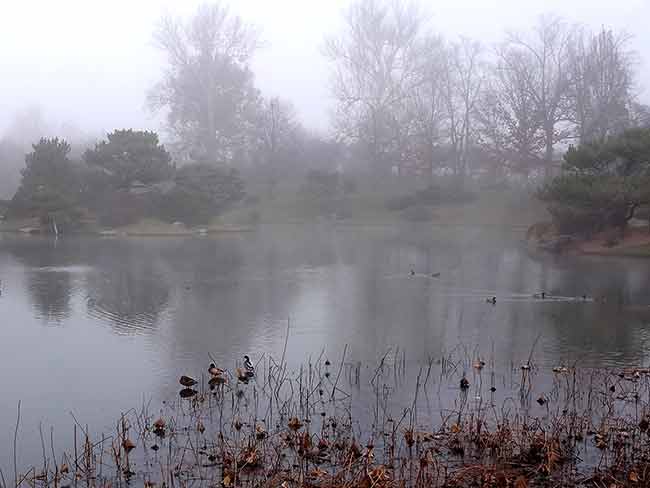


The fog was so thick this morning that I drove to botanical garden on city streets instead of using the interstate. Fog blots out details and vistas. What’s left is a pencil sketch of Garden’s outlines. The Japanese Garden is the idea place to see those outlines.
We visit the Temperate House every week hoping that the buds on fragrant shrubs like the Winter Daphne (Daphne odora) will open. When they do their tightly clustered pale-pink flowers will release a scent akin to a seductive perfume invented in a lab. The buds are in no hurry to open. For months they look ready to pop, but they don’t. Sometime in January or February though they will open and then stay fresh and fragrant for weeks.
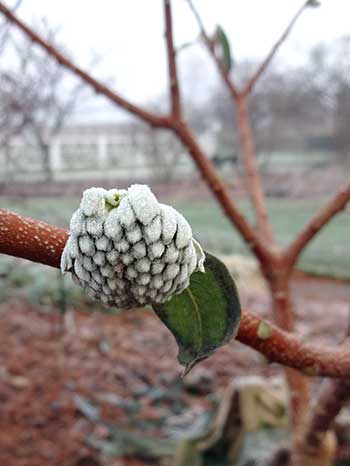 Winter Daphne is grown under glass. Outside though it wouldn’t stand a chance. This morning I saw a member of Daphne’s family growing outside. A label near the shrub called it a Paperbush (Edgeworthia chrysantha ‘Snow Cream’). It’s dropped all of its leaves, but I was still attracted to it because it was filled with these tight pincushions of silver gray bud clusters. From a distance the shrub looked as though it had been decorated with holiday ornaments.
Winter Daphne is grown under glass. Outside though it wouldn’t stand a chance. This morning I saw a member of Daphne’s family growing outside. A label near the shrub called it a Paperbush (Edgeworthia chrysantha ‘Snow Cream’). It’s dropped all of its leaves, but I was still attracted to it because it was filled with these tight pincushions of silver gray bud clusters. From a distance the shrub looked as though it had been decorated with holiday ornaments.
Unlike the indoor daphnes, the Paperbush shrub has a chance of surviving outdoors. It’s a zone 7b to 9 plant. This botanical garden qualifies, but just barely. With a cooperative winter the buds will likely open in late February or early March. Like its indoor relative, once the Paperbush buds open the blooms will last and last and last. All the while they will perfume the air with a fragrance that has been described as “a bit like gardenia with a slightly spicier element” or the “fragrance of honey as well as spice.” One writer simply says, “The fragrance is amazing. I can’t describe it—you will just have to find a specimen and experience it for yourself.” Fingers crossed, in a couple of months I will.
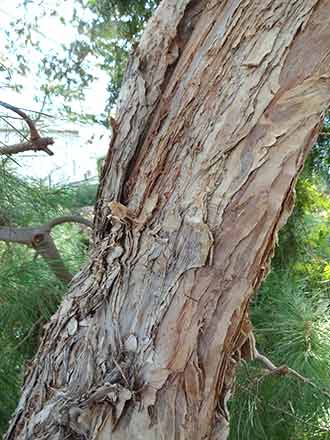 A couple of years ago I was on a tour of the Temperate glass house. The tour guide pointed out the tall Honey Myrtle (Melaleuca linarifolia) tree growing near the garden’s balcony. He said that visitors often paused here to stroke the tree's soft brown bark. He explained that the bark of this Australian native was made of thin sheets of paper-like bark separated by a spongy airy material. I thought of a baklava and its layers of phyllo. Since then whenever I’m in the Temperate House, I give the Honey Myrtle a pet.
A couple of years ago I was on a tour of the Temperate glass house. The tour guide pointed out the tall Honey Myrtle (Melaleuca linarifolia) tree growing near the garden’s balcony. He said that visitors often paused here to stroke the tree's soft brown bark. He explained that the bark of this Australian native was made of thin sheets of paper-like bark separated by a spongy airy material. I thought of a baklava and its layers of phyllo. Since then whenever I’m in the Temperate House, I give the Honey Myrtle a pet.
Recently I learned that the bark of Honey Myrtle has some other abilities. Indigenous peoples believed that the bark had spiritual qualities so they wrapped their dead in the bark. Even now many people believe the bark is magical. Write a wish on a piece of the bark. Bury it for three days, dig it up and then burn it. The smoke will carry your wish straight to God.
Let Your Heart Be Bright
 “Every time a bell rings, an angel gets his wings” — the trust of a child in It’s a Wonderful Life. Wishes, hopes, and beliefs are the stuff of the holidays. Visitors to the botanical garden’s light show are filling a book with their personal wishes for the season. Just inside a gazebo at the entrance to Rose Garden there are four pedestals. On each is a spiral bound book with a pen. Bells dangle from a rope alongside. A sign invites visitors to “Write a wish for the Season. Ring the bell for a reason. Feel the glow and let everyone know.”
“Every time a bell rings, an angel gets his wings” — the trust of a child in It’s a Wonderful Life. Wishes, hopes, and beliefs are the stuff of the holidays. Visitors to the botanical garden’s light show are filling a book with their personal wishes for the season. Just inside a gazebo at the entrance to Rose Garden there are four pedestals. On each is a spiral bound book with a pen. Bells dangle from a rope alongside. A sign invites visitors to “Write a wish for the Season. Ring the bell for a reason. Feel the glow and let everyone know.”
I opened one of the books. Here are a few of the wishes I found:
- World peace
- For our global political leaders to do what is right, true, and good for all
- For us to be noble stewards of our beautiful earth
- To hope that my back and everyone else’s stops hurting
- I wish my cousin returns safely from war
- To get a very good job
- To successfully create a Tesla coil
- That everyone in ISIL wakes up to what they’re doing
- For be forever with Jacob
- That my Sarah gets pregnant
- To live to see my kids all grown up
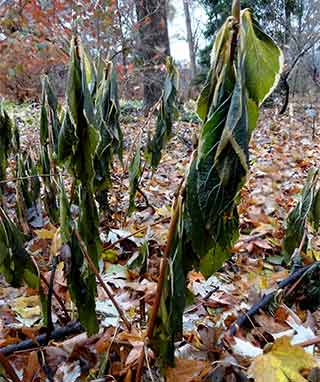 Finally the hard freeze arrived. Nighttime temperatures in the low 20s last week put an end to the lives of flowers and plants still able to get though nights in the low 30s. This morning though all the leaves on the hostas are lifeless. Hydrangeas leaves are deflated too, tightly huddled around their branches.
Finally the hard freeze arrived. Nighttime temperatures in the low 20s last week put an end to the lives of flowers and plants still able to get though nights in the low 30s. This morning though all the leaves on the hostas are lifeless. Hydrangeas leaves are deflated too, tightly huddled around their branches.
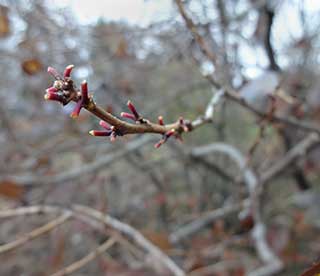 The abundant crop of winterberries growing throughout the botanical garden (Ilex verticillata) is mostly gone. As has happened year after year, migrating flocks of robins are using this botanical garden as a refueling stop on their flight South. This had been a good year for winterberry hollies. After their leaves dropped, the berries glowed on the bare shrubs. This morning I saw just six berries left on the cluster of shrubs used as a backdrop to the life-sized stature of this gardens founder Henry Shaw.
The abundant crop of winterberries growing throughout the botanical garden (Ilex verticillata) is mostly gone. As has happened year after year, migrating flocks of robins are using this botanical garden as a refueling stop on their flight South. This had been a good year for winterberry hollies. After their leaves dropped, the berries glowed on the bare shrubs. This morning I saw just six berries left on the cluster of shrubs used as a backdrop to the life-sized stature of this gardens founder Henry Shaw.
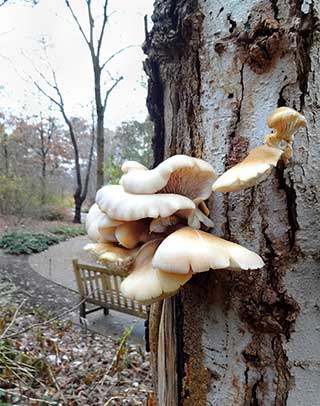 We came across these clusters of shelf-like mushrooms lining the trunk of a Merrill magnolia tree growing in the English Garden. They suddenly appeared after a couple of weeks of heavy, almost constant rain. They look soft and supple – not at all like the hard tough fungal growths that usually grow on stumps of old, decaying trees. After comparing the pictures I took with those I found on Google Images, I’m thinking these growths just might be the highly prized oyster mushrooms. They’re the right size (2 – 8 inches across); they’re growing in clusters; they have a smooth cap with a silvery sheen; their gills extend down along their stalks; and they’ve appeared after this cool, wet spell – all identifying features of oyster mushrooms.
But there's are chance that these identifying features could also match other, less friendly varieties of mushrooms too. Without experience, a mentor, or an identifying marker, I can only guess.
We came across these clusters of shelf-like mushrooms lining the trunk of a Merrill magnolia tree growing in the English Garden. They suddenly appeared after a couple of weeks of heavy, almost constant rain. They look soft and supple – not at all like the hard tough fungal growths that usually grow on stumps of old, decaying trees. After comparing the pictures I took with those I found on Google Images, I’m thinking these growths just might be the highly prized oyster mushrooms. They’re the right size (2 – 8 inches across); they’re growing in clusters; they have a smooth cap with a silvery sheen; their gills extend down along their stalks; and they’ve appeared after this cool, wet spell – all identifying features of oyster mushrooms.
But there's are chance that these identifying features could also match other, less friendly varieties of mushrooms too. Without experience, a mentor, or an identifying marker, I can only guess.
 The annual holiday flower and train show is going on in the botanical garden’s indoor display hall. Lots to see, especially for kids. Aside from the trains, the miniature displays around the train tracks, and the mountains of poinsettias, there’s a lot to admire in how the designers of the show planned the color combinations and placement of the plants and flowers. Here are two examples. Both sides of a walkway formed by used bricks are lined with a brick-perfect match of these small, bushy arrow-leaf plants (Syngonium) called ‘Neon Robusta’.
The annual holiday flower and train show is going on in the botanical garden’s indoor display hall. Lots to see, especially for kids. Aside from the trains, the miniature displays around the train tracks, and the mountains of poinsettias, there’s a lot to admire in how the designers of the show planned the color combinations and placement of the plants and flowers. Here are two examples. Both sides of a walkway formed by used bricks are lined with a brick-perfect match of these small, bushy arrow-leaf plants (Syngonium) called ‘Neon Robusta’.
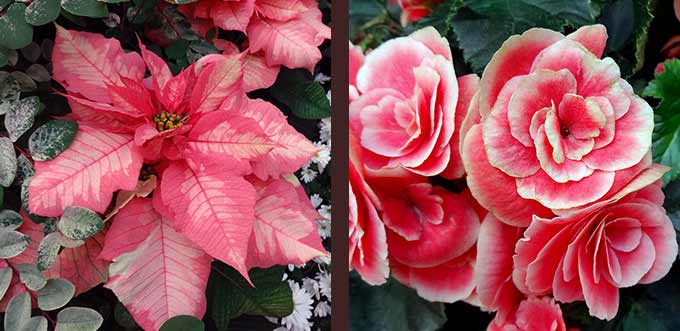 Then there’s this display that uses two tiers of flowering plants. On the top tier are these poinsettias (‘Sparkling Punch’) with pink bracts and a blaze of white down the center. Just below the designers used pots of these deep pink begonias (‘Borias’) trimmed in white.
Then there’s this display that uses two tiers of flowering plants. On the top tier are these poinsettias (‘Sparkling Punch’) with pink bracts and a blaze of white down the center. Just below the designers used pots of these deep pink begonias (‘Borias’) trimmed in white.
Dazzle the Dark
 It's opening night. With temperatures in the comfortable 50s people don't seem to mind waiting in lines or being jostled by the crowds around them.
It's opening night. With temperatures in the comfortable 50s people don't seem to mind waiting in lines or being jostled by the crowds around them.
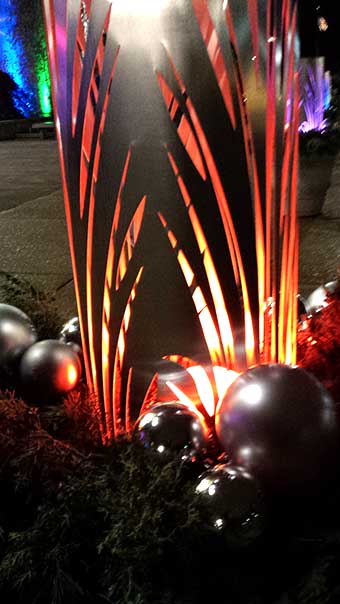 This is the third year of this botanical garden's holiday light display called ‘Garden Glow’. The botanical garden promises visitors a million LED lights this year. That's up from the 600,000 they lit last year. If attendance holds true to form, just under a 100,000 people will pay about $1.3 million to walk among the lights before they go out on January 2.
This is the third year of this botanical garden's holiday light display called ‘Garden Glow’. The botanical garden promises visitors a million LED lights this year. That's up from the 600,000 they lit last year. If attendance holds true to form, just under a 100,000 people will pay about $1.3 million to walk among the lights before they go out on January 2.
As a way to brighten the winter and boast attendance, other botanical gardens are also lighting up. Two the largest light displays are at the Royal Botanical Garden at Kew and the Atlanta Botanical Garden.
This is the third year for the outdoor light display at the Royal Botanical Gardens at Kew outside of London. Kew calls its show by the C-word, ‘Christmas at Kew’. Their theme this year will be Christmas trees. Christmas trees have been a part of the Garden since the 1790s when Queen Charlotte decorated a tree in the Garden's Kew Palace. The display at Kew will feature sculptural-sized light displays of cattails, lilies of the valley, hellebores, and of course snowdrops. Back again will be carousel rides on Victorian-style horses.
The light display at the Atlanta Botanical Garden called ‘Garden Lights, Holiday Nights’. This is the fifth year for the Garden's “annual electrical extravaganza.” They too will have a million lights - all low-energy LEDs. One million LED lights seems to be the benchmark for any properly attired holiday light display. The show in Atlanta features what they call “enormous botanical-inspired light displays.” In previous years those botanical displays have featured lighted sculptures of yellow honey bees in a field of red flowers, a green praying mantis carrying a sack of holiday goodies, a field of over-sized green-lit corn topped with yellow tassels, and towering earth goddess with flowing blue and white-lit hair. This year the Atlanta show will include many “favorites” (displays recycled from previous shows) and some new things like a walk-though “tunnel of light.”
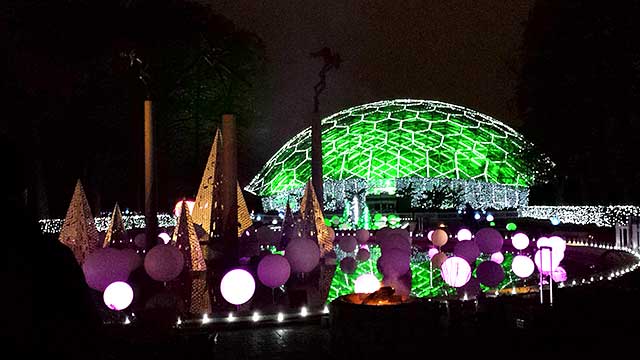 But back to the ‘Garden Glow’ at this botanical garden. Anyone who likes lights - especially the spacey colors that LEDs can mimic -- will have a grand time. The light designers have skillfully put together bright pinks, fuchsias, blues, greens, and gold to make dazzling displays. Glow balls in LED pastel colors fill the reflecting ponds and slowly shift from green, orange, pink, turquoise, and white in time to tunes from the Nutcracker.
But back to the ‘Garden Glow’ at this botanical garden. Anyone who likes lights - especially the spacey colors that LEDs can mimic -- will have a grand time. The light designers have skillfully put together bright pinks, fuchsias, blues, greens, and gold to make dazzling displays. Glow balls in LED pastel colors fill the reflecting ponds and slowly shift from green, orange, pink, turquoise, and white in time to tunes from the Nutcracker.
 The two eye-popping displays are the Garden's geodesic dome with its lattice shell outlined in green and white lights and a huge sweet gum tree with all its branches outlined in blue lights.
The two eye-popping displays are the Garden's geodesic dome with its lattice shell outlined in green and white lights and a huge sweet gum tree with all its branches outlined in blue lights.
 However, the displays that line the walk through the fields of lights are neither interesting, nor new, nor imaginative. Most have been brought out of storage from the show last year. They are generic displays of sculptural trees, snowballs, and gazebos, and reindeer.
However, the displays that line the walk through the fields of lights are neither interesting, nor new, nor imaginative. Most have been brought out of storage from the show last year. They are generic displays of sculptural trees, snowballs, and gazebos, and reindeer.
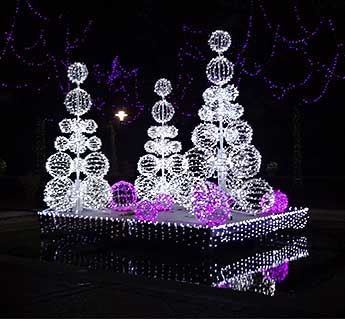 There is nothing distinctive here to let your know you are walking is a botanical garden that by day is filled with unique trees and remarkable plants. Absent too are any displays tied to Garden's mission of connecting people to plants. Garden Glow is a just another display of holiday lights - a very good one, a very elaborate one - but one without roots in what a botanical garden like this one is and does.
There is nothing distinctive here to let your know you are walking is a botanical garden that by day is filled with unique trees and remarkable plants. Absent too are any displays tied to Garden's mission of connecting people to plants. Garden Glow is a just another display of holiday lights - a very good one, a very elaborate one - but one without roots in what a botanical garden like this one is and does.
Light the Lights
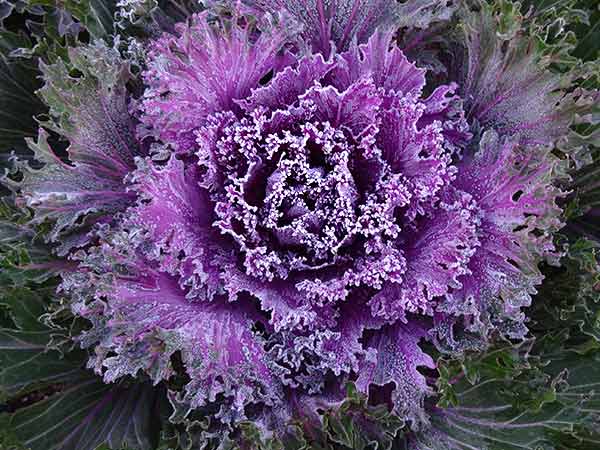 Nights drop below freezing, but we’re still waiting for the season-ending killing frost. Touches of frost on these ornamental kales in the Ottoman Garden look as though landscape artist Bob Ross might have taken his happy little brush and given their edges just a hint of light.
Nights drop below freezing, but we’re still waiting for the season-ending killing frost. Touches of frost on these ornamental kales in the Ottoman Garden look as though landscape artist Bob Ross might have taken his happy little brush and given their edges just a hint of light.
 Most trees have colored already. Many have dropped their leaves. The ginkgos in the Garden have just started to golden though. Ginkgos color quickly and brilliantly. Then when they reach their full color, they have a meeting to decide when to drop their leaves. On the appointed day 90% of the leaves fall. The remaining 10% either didn’t attend the meeting or are free thinkers.
Most trees have colored already. Many have dropped their leaves. The ginkgos in the Garden have just started to golden though. Ginkgos color quickly and brilliantly. Then when they reach their full color, they have a meeting to decide when to drop their leaves. On the appointed day 90% of the leaves fall. The remaining 10% either didn’t attend the meeting or are free thinkers.
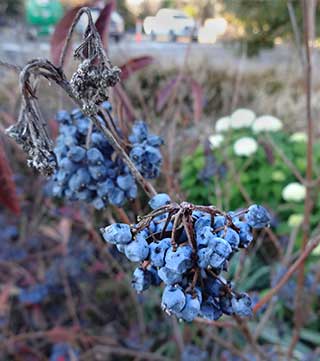 A couple of years ago, this botanical garden redid its parking lots. They turned them into what they call ‘Eco-Lots’. Cars still park on asphalt, but this new asphalt allows the rainwater to drain through its surface. The runoff is then caught and the pollutants are filtered. Runoff is also trapped in several large rain gardens that border the lots. This morning I saw this striking viburnum growing in one of the rain gardens. In mid-November, anything this blue seems more likely to be found on string of holiday lights than in a cluster of berries. This viburnum was thriving in a damp hole several feet below the surface of the parking lot. I couldn’t find a label for it but I think it’s an arrow wood viburnum called Blue Muffin (Viburnum dentatum Blue Muffin). I’d read about blue berries on a viburnum, but had never seen them before today. I’d asked about them though. People who knew said they’d never plant a viburnum with blue berries. Blue they said were the birds’ first choice. So why, they reasoned, plant a shrub with blue berries if you never get to see them? The birds haven’t found these Blue Muffins yet, so have a look before they do. The shrubs are at the edge of the West parking lot.
A couple of years ago, this botanical garden redid its parking lots. They turned them into what they call ‘Eco-Lots’. Cars still park on asphalt, but this new asphalt allows the rainwater to drain through its surface. The runoff is then caught and the pollutants are filtered. Runoff is also trapped in several large rain gardens that border the lots. This morning I saw this striking viburnum growing in one of the rain gardens. In mid-November, anything this blue seems more likely to be found on string of holiday lights than in a cluster of berries. This viburnum was thriving in a damp hole several feet below the surface of the parking lot. I couldn’t find a label for it but I think it’s an arrow wood viburnum called Blue Muffin (Viburnum dentatum Blue Muffin). I’d read about blue berries on a viburnum, but had never seen them before today. I’d asked about them though. People who knew said they’d never plant a viburnum with blue berries. Blue they said were the birds’ first choice. So why, they reasoned, plant a shrub with blue berries if you never get to see them? The birds haven’t found these Blue Muffins yet, so have a look before they do. The shrubs are at the edge of the West parking lot.
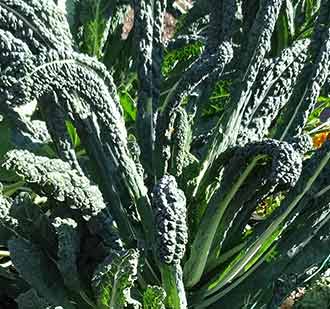 Late season veggies are still producing in the Kemper gardens. The familiar Brussel sprouts, cabbages, and chard are all there. New to me though was this veggie labeled ‘Nero di Toscano’ Cabbage. Other names I found for it were black cabbage, dinosaur kale, and black palm. Its dark colored shapely leaves covered with close puckering makes it look like some kind of fall ornament akin to the ornamental kale in the Ottoman Garden. Not so. It’s an essential ingredient for hardy soups and stews made this time of year in the Tuscan region of Italy. Ribollita or reboiled bean soup is the best known of them. It’s a thick veggie and bean soup, much like a minestrone. The black kale leaves are used because they’re reported to have lightly sweeter, more delicate taste than curly-leaved kale. Nero di Toscano is said to be very tolerant of cold weather and in fact only develops its sweet rich flavor after a freeze.
Late season veggies are still producing in the Kemper gardens. The familiar Brussel sprouts, cabbages, and chard are all there. New to me though was this veggie labeled ‘Nero di Toscano’ Cabbage. Other names I found for it were black cabbage, dinosaur kale, and black palm. Its dark colored shapely leaves covered with close puckering makes it look like some kind of fall ornament akin to the ornamental kale in the Ottoman Garden. Not so. It’s an essential ingredient for hardy soups and stews made this time of year in the Tuscan region of Italy. Ribollita or reboiled bean soup is the best known of them. It’s a thick veggie and bean soup, much like a minestrone. The black kale leaves are used because they’re reported to have lightly sweeter, more delicate taste than curly-leaved kale. Nero di Toscano is said to be very tolerant of cold weather and in fact only develops its sweet rich flavor after a freeze.
 “Garden Glow” – the third reincarnation of this botanical garden’s outdoor holiday light show – begins next weekend. The lights are in place – all one million of them. This morning an electrician is testing each display to make sure the strings of lights come on when they’re supposed to. The major displays and the placement of lights seem to be much as they were last year. That may be disappointing to some who come expecting to see some new, even grander spectacle. Still most visitors probably won’t notice or even care. Strolling along walkways festooned with lights is exactly what they paid to experience.
“Garden Glow” – the third reincarnation of this botanical garden’s outdoor holiday light show – begins next weekend. The lights are in place – all one million of them. This morning an electrician is testing each display to make sure the strings of lights come on when they’re supposed to. The major displays and the placement of lights seem to be much as they were last year. That may be disappointing to some who come expecting to see some new, even grander spectacle. Still most visitors probably won’t notice or even care. Strolling along walkways festooned with lights is exactly what they paid to experience.
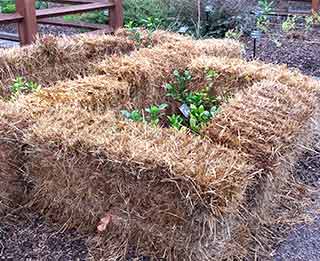 Tried it in 2013 and it failed. No matter what kind of shelter a half dozen Zone 8 gardenias were given to protect them from this Zone 6b winter, they all died. Time to try again. More than a half dozen gardenia shrubs have been planted inside of barricade of straw piled three bales high. The gardenias along with dozens of other plants growing nearby are part of the botanical garden’s “Climate Garden.” None of the plants chosen for this garden are hardy in this zone. They all come from warmer places along the gulf coast. The plant patients will be monitored regularly during the winter to see if they live, die, or just manage to hold on. This experiment makes me think of a blog entry I read that imagined an organization called the ASPCP -- ‘American Society for the Prevention of Cruelty to Plants’. Its mission would be to protect plants from the human idea of how and where plants should grow. “Who knows,” the blogger writes, “maybe there will be a Forsythia Rescue League who will save tortured Forsythias that have forever been pruned to 3 to 4 feet in the shaped of an ice cream cone and they will plant them in places where they can go wild and flower like crazy.”
Tried it in 2013 and it failed. No matter what kind of shelter a half dozen Zone 8 gardenias were given to protect them from this Zone 6b winter, they all died. Time to try again. More than a half dozen gardenia shrubs have been planted inside of barricade of straw piled three bales high. The gardenias along with dozens of other plants growing nearby are part of the botanical garden’s “Climate Garden.” None of the plants chosen for this garden are hardy in this zone. They all come from warmer places along the gulf coast. The plant patients will be monitored regularly during the winter to see if they live, die, or just manage to hold on. This experiment makes me think of a blog entry I read that imagined an organization called the ASPCP -- ‘American Society for the Prevention of Cruelty to Plants’. Its mission would be to protect plants from the human idea of how and where plants should grow. “Who knows,” the blogger writes, “maybe there will be a Forsythia Rescue League who will save tortured Forsythias that have forever been pruned to 3 to 4 feet in the shaped of an ice cream cone and they will plant them in places where they can go wild and flower like crazy.”
It's Getting To Be That Time
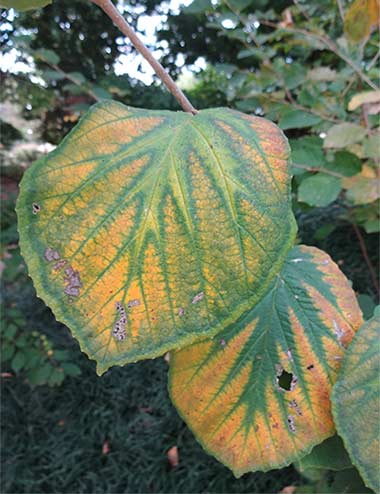 Cooler days, chilly nights. At this botanical garden summer displays are systematically being ripped out, fountains are being drained, and tender plants are being dug up and stored away in greenhouses. The leaves on plants and trees are responding to the changes too - some by browning and shriveling; some by coloring.
Cooler days, chilly nights. At this botanical garden summer displays are systematically being ripped out, fountains are being drained, and tender plants are being dug up and stored away in greenhouses. The leaves on plants and trees are responding to the changes too - some by browning and shriveling; some by coloring.
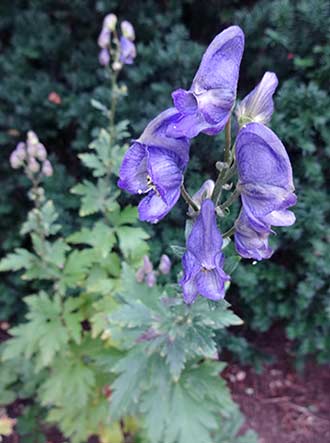 Aconites (Aconitum napellus) have started to bloom in the Ottoman Garden. I've long known they're as deadly as they are beautiful. This year though they seem even more ominous. I think it's because when I see them I reminded of some episodes of the Showtime series Dexter that I've been watching on DVD. Dexter is blood spatter analyst who works for the Miami Police Department when he's not busy being a serial killer with a conscience. In Season 7 Dexter takes up with a woman who grows and sells orchids to her upscale customers. She also grows a patch of aconite plants for her own private use. She finds the roots and leaves come in handy when she wants to prepare a deadly last supper for anyone who gets in her way.
Aconites (Aconitum napellus) have started to bloom in the Ottoman Garden. I've long known they're as deadly as they are beautiful. This year though they seem even more ominous. I think it's because when I see them I reminded of some episodes of the Showtime series Dexter that I've been watching on DVD. Dexter is blood spatter analyst who works for the Miami Police Department when he's not busy being a serial killer with a conscience. In Season 7 Dexter takes up with a woman who grows and sells orchids to her upscale customers. She also grows a patch of aconite plants for her own private use. She finds the roots and leaves come in handy when she wants to prepare a deadly last supper for anyone who gets in her way.
This botanical garden has never labeled plants as poisonous or toxic. Perhaps that's by design. Calling attention to a plant might trigger the very incidents that the signs warn against.
 To eat a fig from a tree you've grown is a splendid thing especially in parts of the country where figs ought not grow. My father had a fig tree that he planted on the south side of a sheltering barn. It grew there for years but never got much bigger than a scraggly shrub. Occasionally it produced a few small figs that my dad would proudly slice and share with anyone who cared to have a taste. Figs are trees of warm places. But here because figs are such rare gifts, I always look at the fig shrub (Ficus carica) growing in the Ottoman garden to see how its doing. This year it has a few figs on it that will never ripen and lots of leaves that look as though they'd be more comfortable in California than here in the Midwest.
To eat a fig from a tree you've grown is a splendid thing especially in parts of the country where figs ought not grow. My father had a fig tree that he planted on the south side of a sheltering barn. It grew there for years but never got much bigger than a scraggly shrub. Occasionally it produced a few small figs that my dad would proudly slice and share with anyone who cared to have a taste. Figs are trees of warm places. But here because figs are such rare gifts, I always look at the fig shrub (Ficus carica) growing in the Ottoman garden to see how its doing. This year it has a few figs on it that will never ripen and lots of leaves that look as though they'd be more comfortable in California than here in the Midwest.
 Last chance to see some banana plants named ‘Little Prince’. Look for them in the Victorian Garden where they've been planted as centerpieces in beds of white pentas. These bananas fit right in. They are no taller than the 5 - 6 foot high cannas in the surrounding beds and their leaf shape, texture, and color fit well among the begonias, vinca, and elephant ears growing on all sides of them. Somewhere ‘Little Prince’ may flower. Somewhere it may actually produce a banana. Not here though. In this garden it's a stocky, muscular compact plant with leaves so tough that winds can't shred or tater their edges.
Last chance to see some banana plants named ‘Little Prince’. Look for them in the Victorian Garden where they've been planted as centerpieces in beds of white pentas. These bananas fit right in. They are no taller than the 5 - 6 foot high cannas in the surrounding beds and their leaf shape, texture, and color fit well among the begonias, vinca, and elephant ears growing on all sides of them. Somewhere ‘Little Prince’ may flower. Somewhere it may actually produce a banana. Not here though. In this garden it's a stocky, muscular compact plant with leaves so tough that winds can't shred or tater their edges.
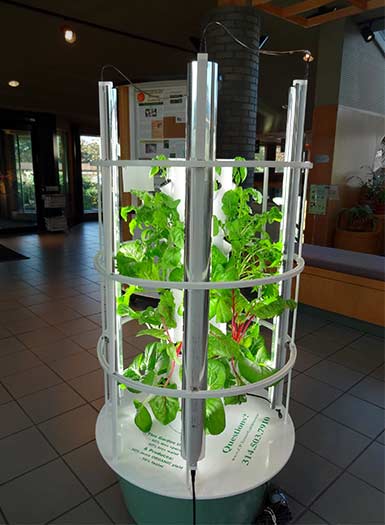 Chard, lettuce, arugula, basil and bok choy are growing inside the Kemper Center. They're growing under lights and they're growing without soil. This white plastic tower that would look at home in a science fiction movie has plants dangling out of its 20 pockets all along its five foot tower. It's called a ‘Tower Garden’. Stripped down to the basics it's a plastic tube inside a tub at the bottom. It's a simple design disguising a complex growing system called aeoponics. Water laced with chemical nutrients is pumped up from the 20 gallon tub below and allowed to evenly cascade over the roots of all the plants placed in the pockets. Some plants are reported to come to harvest 30% faster with this bath of nutrient water and unrestricted oxygen. On a small scale this is a view of what some think might be the future of urban agriculture with stories high banks of plants growing in windowless warehouses lit only by LED lights.
Chard, lettuce, arugula, basil and bok choy are growing inside the Kemper Center. They're growing under lights and they're growing without soil. This white plastic tower that would look at home in a science fiction movie has plants dangling out of its 20 pockets all along its five foot tower. It's called a ‘Tower Garden’. Stripped down to the basics it's a plastic tube inside a tub at the bottom. It's a simple design disguising a complex growing system called aeoponics. Water laced with chemical nutrients is pumped up from the 20 gallon tub below and allowed to evenly cascade over the roots of all the plants placed in the pockets. Some plants are reported to come to harvest 30% faster with this bath of nutrient water and unrestricted oxygen. On a small scale this is a view of what some think might be the future of urban agriculture with stories high banks of plants growing in windowless warehouses lit only by LED lights.
Tower Gardens like this one sell for $525. Equipped with lights and a support cage, add another $280. Additional supplies of nutrients are $60 per order. Buying a Tower Garden can't be a decision based on balancing cost and outcomes. Like having the latest smart phone or highest resolution television, the decision to buy a Tower has to be based on wanting to be an early adopter - of being one of the special select few who tries something new and different and perhaps better.
Apart from cost, some people have reservations about whether plants even ought to be grown without soil. A blog posting headlined “Beware of Tower Gardens” warns us to "Beware of any methods of growing food that are drastically different from God's intended design."
From One Come Many
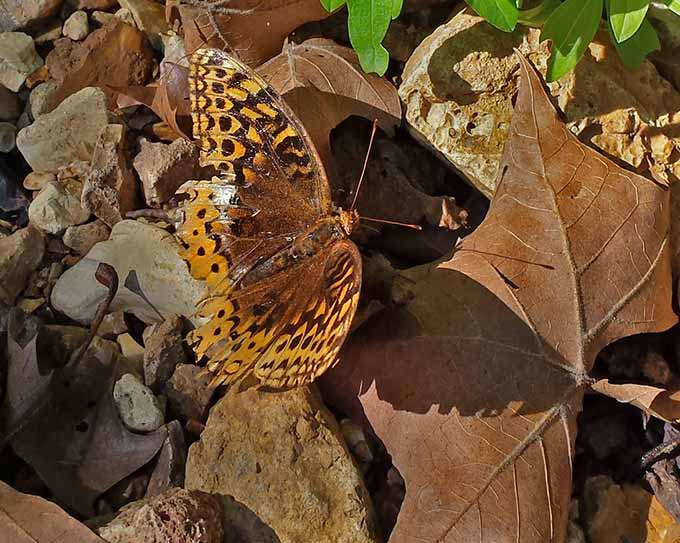 It's not over yet, but it's coming close. Deep in September this great spangled fritillary poking among the first fallen leaves. Its wings are tattered; its colors are faded, and its once crisp markings have gotten fuzzy. It doesn't fly very well either. Still it's here. This is a female. Only they survive this long. She probably emerged in late June and mated soon after. Then after taking a nap for a few weeks, she found a clump of violet leaves and laid thousands of eggs. In other week, she will be gone. Still she is here today and so am I.
It's not over yet, but it's coming close. Deep in September this great spangled fritillary poking among the first fallen leaves. Its wings are tattered; its colors are faded, and its once crisp markings have gotten fuzzy. It doesn't fly very well either. Still it's here. This is a female. Only they survive this long. She probably emerged in late June and mated soon after. Then after taking a nap for a few weeks, she found a clump of violet leaves and laid thousands of eggs. In other week, she will be gone. Still she is here today and so am I.
The young Princess tree (Paulownia tomentosa) at the edge of the iris Garden was cut down in the spring. We wondered why. It was the smallest and newest of the trees. It looked healthy. The stump showed no trace of decay or rot. We thought the stump would be removed too, but it never was. Now I see why.
Jane Goodall put me on the right track. In her book Seeds of Hope she writes about how the root systems of “clonal trees” enable them to survive for thousands of years. She writes that the Pando colony of aspens in Utah is a single genetic organism with a massive root system that spreads out more than a hundred acres. While individual aspens age and die, new trees with the same genetic makeup take their place as they sprout from root collars, stumps, and roots.
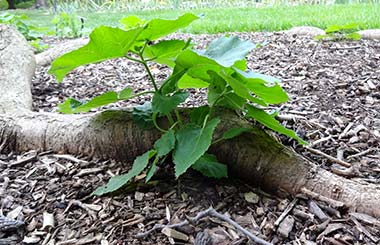 This morning I walked back to where the young Princess tree had been. New growth was spouting from its root collar and from its shallow root lines for at least thirty feet from the stump. Like the aspen, the Paulownia is a clonal tree too. So by cutting the old tree, many new trees will begin to grow. Now that I see what this Paulownia is doing, I remembered seeing something similar when I visited Longwood Gardens.
There they have a perfect alee of straight, shapely Paulownia trees - all with a single trunk about a foot around. At Longwood these trees that ordinarily tend to be free-spirited are behaving well. Like the Paulownia tree in this botanical garden, they were cut down and their stumps and roots grew new shoots too. But at Longwood, only the ones with the truest, straightest stems were allowed to grow up to become trees.
This morning I walked back to where the young Princess tree had been. New growth was spouting from its root collar and from its shallow root lines for at least thirty feet from the stump. Like the aspen, the Paulownia is a clonal tree too. So by cutting the old tree, many new trees will begin to grow. Now that I see what this Paulownia is doing, I remembered seeing something similar when I visited Longwood Gardens.
There they have a perfect alee of straight, shapely Paulownia trees - all with a single trunk about a foot around. At Longwood these trees that ordinarily tend to be free-spirited are behaving well. Like the Paulownia tree in this botanical garden, they were cut down and their stumps and roots grew new shoots too. But at Longwood, only the ones with the truest, straightest stems were allowed to grow up to become trees.
 The pads of prickly pear cactus (Opuntia littoralis) growing outside the Linnean glasshouse have finally sprouted. It's clear now that the pads were cut off deliberately from the large plant and pressed into the soil to encourage roots to form and new cactus buds to emerge. Another clone is born.
The pads of prickly pear cactus (Opuntia littoralis) growing outside the Linnean glasshouse have finally sprouted. It's clear now that the pads were cut off deliberately from the large plant and pressed into the soil to encourage roots to form and new cactus buds to emerge. Another clone is born.
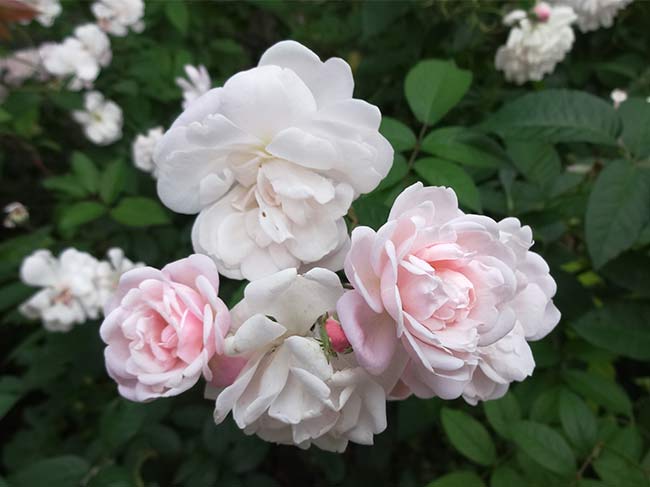 Old pleasures. Return to a place time after time, season after season, year after year, and you begin to look for old friends. Time after time I look for this old friend who I know will be here, re energized by shorter days and cooler temperatures. This Polyantha rose ‘Marie Pavie’ is filled with small unassuming watercolor-like pink frizzy flowers this morning. They may not be much to look at, but smell them. To me, 'Marie Pavie' is the benchmark, the gold standard of fragrance, against which all other roses can only try to measure up.
Old pleasures. Return to a place time after time, season after season, year after year, and you begin to look for old friends. Time after time I look for this old friend who I know will be here, re energized by shorter days and cooler temperatures. This Polyantha rose ‘Marie Pavie’ is filled with small unassuming watercolor-like pink frizzy flowers this morning. They may not be much to look at, but smell them. To me, 'Marie Pavie' is the benchmark, the gold standard of fragrance, against which all other roses can only try to measure up.
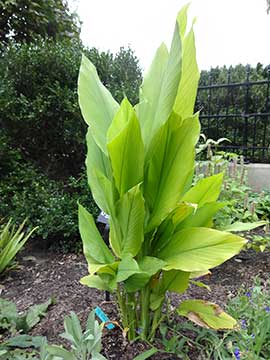 I almost missed these new additions to the Herb Garden at back of Tower Grove House when I walked through this morning. They're ordinary cannas I first thought at first glance. Then I wondered why cannas - certainly not herbs - would have been planted here. So I went back to look again. The plants with the broad yellow-green leaves aren't cannas, but turmeric (Curcuma longa) instead. Before today, curry powder was as close as I'd ever come to termeric, although I do have a friend who told me her husband was taking the powder to complement his other cancer treatments. Seeing it growing here as a live plant ties beginnings and endings together a little better for me. Too bad it's too late in the season to see the turmeric in bloom. But as interesting as leaves and foliage may be, the plant's got the goods in its underground bright yellow rhizomes that are grated or powdered.
I almost missed these new additions to the Herb Garden at back of Tower Grove House when I walked through this morning. They're ordinary cannas I first thought at first glance. Then I wondered why cannas - certainly not herbs - would have been planted here. So I went back to look again. The plants with the broad yellow-green leaves aren't cannas, but turmeric (Curcuma longa) instead. Before today, curry powder was as close as I'd ever come to termeric, although I do have a friend who told me her husband was taking the powder to complement his other cancer treatments. Seeing it growing here as a live plant ties beginnings and endings together a little better for me. Too bad it's too late in the season to see the turmeric in bloom. But as interesting as leaves and foliage may be, the plant's got the goods in its underground bright yellow rhizomes that are grated or powdered.
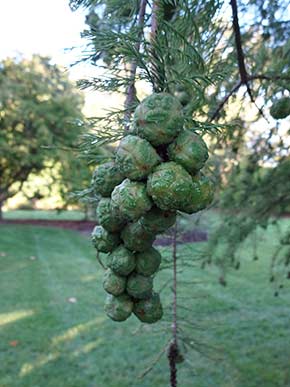 A few of the bald cypress trees have clusters of round cone fruits hanging from the ends of their branches. Inside are the seeds of new beginnings. Right now they have a comical look -- like Brussel sprout stocks hung out to dry.
A few of the bald cypress trees have clusters of round cone fruits hanging from the ends of their branches. Inside are the seeds of new beginnings. Right now they have a comical look -- like Brussel sprout stocks hung out to dry.
 Autumn crocuses (Colchicum) are in full bloom throughout the botanical garden. Newly planted bulbs tend to have one, maybe two flowers that flop to the ground and just stay there. Older plantings though have colonized to form bouquets of purple blooms that band together to support their weaker stemmed neighbors.
Autumn crocuses (Colchicum) are in full bloom throughout the botanical garden. Newly planted bulbs tend to have one, maybe two flowers that flop to the ground and just stay there. Older plantings though have colonized to form bouquets of purple blooms that band together to support their weaker stemmed neighbors.
Why Are We Here?
Early morning visitors to the botanical garden come here for lots of reasons. Some come to walk with friends; many come to take photographs in the early light. A few come to ring the bells on the Bell Tree in hopes that good things will never desert them. Today I saw a man who wanted to be in the Ottoman Garden all alone so he could sit in the Sultan’s throne and sing ‘Amazing Grace’ as loudly as he wanted. In the scented garden I met a man who was rubbing a basil leaf from each of the varieties planted here. He told me he was a chef in a Chinese restaurant and that there they always used a variety called Sweet Thai Basil. He said he wanted to smell some of the other varieties of basil to compare their scents with the one he was used to using. As we rubbed leaves and sniffed the aromas, he pointed out that while each of the varieties has a distinctive basil scent, each has distinctive underlying notes – some anise, some clove, some cinnamon, and often citrus.
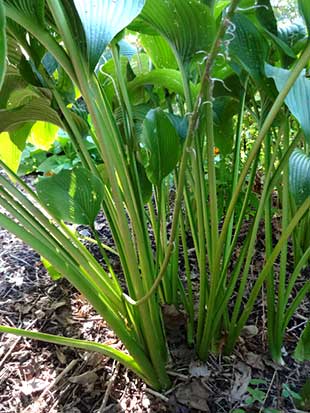 I plant hostas in large decorative pots, but they never seem to belong there. The pot always dominates the plant. My hostas, even the variegated varieties, still end up looking like inconsequential tufts on top. This morning I found a hosta that will put any pot in its place. It’s in the English Woodland Garden. I’ve seen it there before but never was able to look at it up close because it was obscured by the other plants between it and the walkway. This morning the vegetation between the hosta and me has been removed so I can see it clearly from all sides.
I plant hostas in large decorative pots, but they never seem to belong there. The pot always dominates the plant. My hostas, even the variegated varieties, still end up looking like inconsequential tufts on top. This morning I found a hosta that will put any pot in its place. It’s in the English Woodland Garden. I’ve seen it there before but never was able to look at it up close because it was obscured by the other plants between it and the walkway. This morning the vegetation between the hosta and me has been removed so I can see it clearly from all sides.
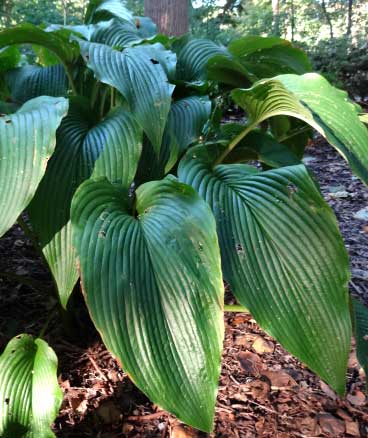 The hosta is named ‘Jade Cascade.’ It’s nearly three feet tall and would easily fill a patio-sized container. The leaves are impressive too – a dark green with prominent, gently curving veins. But the best thing about ‘Jade Cascade’ is what hosta people call its “vase-shape” – long, bare stems that splay out as they grow. It’s a treat to be able to get this kind of an anatomical look at hosta. Here’s a look at how ‘Jade Cascade’ might look in a large container.
The hosta is named ‘Jade Cascade.’ It’s nearly three feet tall and would easily fill a patio-sized container. The leaves are impressive too – a dark green with prominent, gently curving veins. But the best thing about ‘Jade Cascade’ is what hosta people call its “vase-shape” – long, bare stems that splay out as they grow. It’s a treat to be able to get this kind of an anatomical look at hosta. Here’s a look at how ‘Jade Cascade’ might look in a large container.
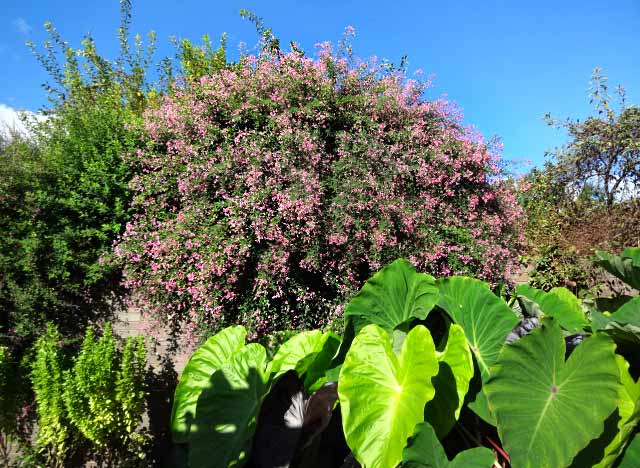 Cascading over the walls of one of the Kemper Gardens are three or four shrubs of a plant named ‘Bush Clover’ (Lespedeza thunbergii). They go unnoticed for most of the year. But in mid-September when they explode in flower, the small pea-like flowers become a magnet for bees and a must-see attraction for visitors who step back a few feet to take in the whole six-foot high shrub filled with white or rosy purple hues. A nursery that sells Bush Clover writes “it's quite easy to become enamored of them. They require so little care but give so much pleasure.” The plants are legumes so like peas and beans them they take nitrogen from air and release it into the soil.
Cascading over the walls of one of the Kemper Gardens are three or four shrubs of a plant named ‘Bush Clover’ (Lespedeza thunbergii). They go unnoticed for most of the year. But in mid-September when they explode in flower, the small pea-like flowers become a magnet for bees and a must-see attraction for visitors who step back a few feet to take in the whole six-foot high shrub filled with white or rosy purple hues. A nursery that sells Bush Clover writes “it's quite easy to become enamored of them. They require so little care but give so much pleasure.” The plants are legumes so like peas and beans them they take nitrogen from air and release it into the soil.
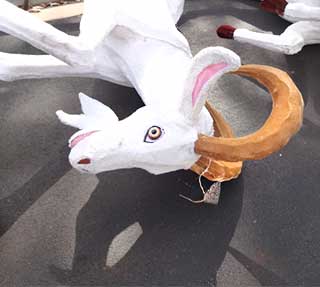 Remnants of the Chinese Lantern Festival are being sold this weekend. Birds, goats, elephants, horses, and emperors lay flat on the asphalt parking lot with price tags tied around their necks. The porcelain plates and cups that once formed magnificent elephants perched on their hind legs are now in the $1 bargain bins at the end of the lot.
Remnants of the Chinese Lantern Festival are being sold this weekend. Birds, goats, elephants, horses, and emperors lay flat on the asphalt parking lot with price tags tied around their necks. The porcelain plates and cups that once formed magnificent elephants perched on their hind legs are now in the $1 bargain bins at the end of the lot.
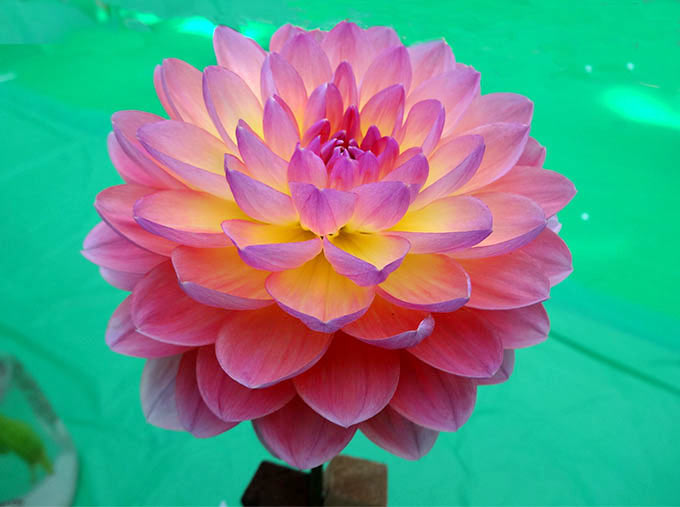 A winner in the Dahlia Society Show at the botanical garden: this water lily dahlia named 'Wildwood Marie'
A winner in the Dahlia Society Show at the botanical garden: this water lily dahlia named 'Wildwood Marie'
And We All Slow Down
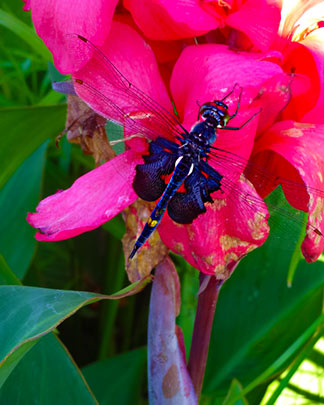 A week ago the display gardens around the ponds in front of the Linnean House were alive with bees and dragon flies. It was in the 80’s then. This morning it’s in the mid-55’s. The insects are still here, but they’re sluggishly clinging to flowers waiting for the sun to warm things up. It’s a rare morning when I can get close enough to a dragon fly to take its picture.
A week ago the display gardens around the ponds in front of the Linnean House were alive with bees and dragon flies. It was in the 80’s then. This morning it’s in the mid-55’s. The insects are still here, but they’re sluggishly clinging to flowers waiting for the sun to warm things up. It’s a rare morning when I can get close enough to a dragon fly to take its picture.
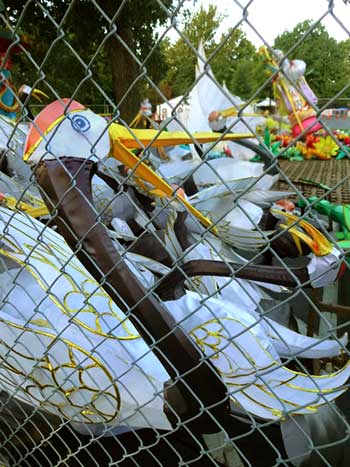 The Chinese Lantern Festival that lasted all summer has ended. Nearly all of the lanterns have been dismantled and moved inside a chain link enclosure on the parking lot. The plan is to try to sell off the component pieces next weekend to anyone who wants to “own a piece of the magic.” After a summer of heat, sun, and rain, the fabric that made the magic has faded badly and lights inside are gone, but the bones remain intact waiting for a new owner to breathe new magic into these fixer-uppers.
The Chinese Lantern Festival that lasted all summer has ended. Nearly all of the lanterns have been dismantled and moved inside a chain link enclosure on the parking lot. The plan is to try to sell off the component pieces next weekend to anyone who wants to “own a piece of the magic.” After a summer of heat, sun, and rain, the fabric that made the magic has faded badly and lights inside are gone, but the bones remain intact waiting for a new owner to breathe new magic into these fixer-uppers.
I didn’t want another daylily. I don’t need another daylily. But I went to the daylily society’s annual sale anyway. The display hall was filled with tables covered with net bags of freshly dug daylilies arranged in alphabetical order by cultivar. Inside the hall I was met by a society member who asked if she might be of help. I told her I was there to browse because as much as I liked daylilies I couldn’t grow them because my garden area had too much shade. She nodded agreeably, “I have the same problem.” She told me that I ought to try planting some specie daylilies because they’re tough enough to deal with the shade while still producing a respectable number of flowers. “In fact, a bit of shade is of an advantage,” she said. “It slows down the bud formation so your blooming season will last longer,” and besides she went on, “The species varieties have very tall scapes – better to catch the sun you, know.” She told me she had just the thing for me as she led me over to the “C” table. She riffled though the bags looking for a variety called ‘Citrina’ while telling me that she hoped there were some left because she had sold a couple of bags already. She finally found a bag of ‘Citrina.” Holding it up to me she said that it had yellow blooms, not the “old, predictably orange.” Then she added the clincher: “‘Citrina’ is one of very few daylilies that have a fragrance. It has a nice fresh lemony scent that fills the night when the flowers start to open at dusk and lasts until they close around noon the next.” I thanked her and left with a bag of ‘Citrina.’ I wish they had had more.
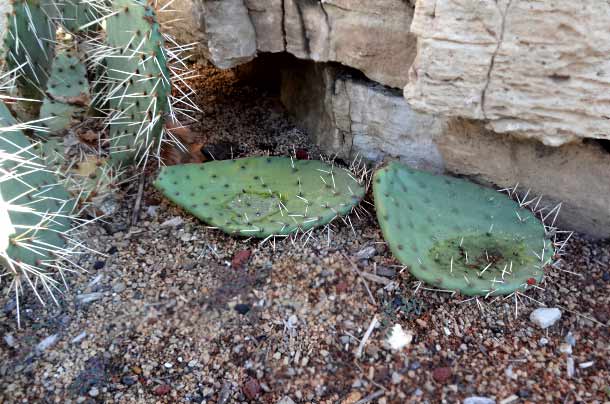 For months now we’ve noticed these two pads of prickly pear cactus (Opuntia littoralis) growing outside the Linnean glasshouse that someone removed from the main plant. We’ve wondered about them. Why haven’t they been removed? Like the broken windows theory of policing, won’t these two broken off pieces encourage more of the same? Maybe though, the pieces were cut off deliberately and left there to root new cactuses. I checked the web. According to an extension officer at Colorado State that’s likely what happened. “To start new prickly pear cactus plants from an existing one, cut off a few individual pads of the prickly pear with a long, sharp knife. Cut at the pad joint. Let each section or pad sit so that the cut section dries a little, perhaps for a day or two. Then place each pad cut side down in sandy soil. . . . Each pad section should develop roots within several weeks to two months.”
For months now we’ve noticed these two pads of prickly pear cactus (Opuntia littoralis) growing outside the Linnean glasshouse that someone removed from the main plant. We’ve wondered about them. Why haven’t they been removed? Like the broken windows theory of policing, won’t these two broken off pieces encourage more of the same? Maybe though, the pieces were cut off deliberately and left there to root new cactuses. I checked the web. According to an extension officer at Colorado State that’s likely what happened. “To start new prickly pear cactus plants from an existing one, cut off a few individual pads of the prickly pear with a long, sharp knife. Cut at the pad joint. Let each section or pad sit so that the cut section dries a little, perhaps for a day or two. Then place each pad cut side down in sandy soil. . . . Each pad section should develop roots within several weeks to two months.”
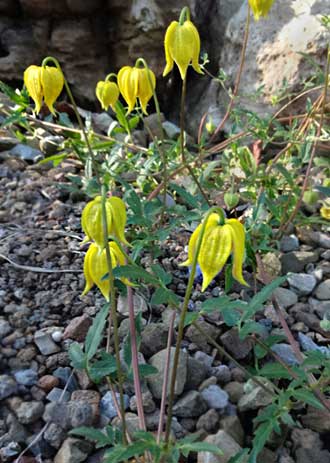 White patches of autumn clematis are lighting up backyard trellis and the upper branches of trees along the roadsides. Like the summer varieties, the autumn flowers are also star-shaped, but very tiny when compared to the palmed-sized blooms of the pink, purple, and white flowers of summer.
White patches of autumn clematis are lighting up backyard trellis and the upper branches of trees along the roadsides. Like the summer varieties, the autumn flowers are also star-shaped, but very tiny when compared to the palmed-sized blooms of the pink, purple, and white flowers of summer.
This morning we saw this fall blooming clematis that was unlike any variety we’d seen before. Its vines were scrambling over the rocks in the Alpine Garden. And instead of the familiar star-shaped flowers, this one had a single lantern-shaped lemon-colored flower atop a five-inch tall stem. A tag alongside identified the plant as Clemantis tibetana subsp. vernayi, a native of the Himalayas. So then, what’s the link? What makes a clematis a clematis? I checked Flora, A Garden’s Encyclopedia for an answer. It says that there over 200 species of clematis. Most climb, but not all do. A lot of them lose their leaves in the winter, but many are evergreen. They flower at any time in any color in any shape. Summing up, Flora says, “There seems to be a clemantis for any season and place.” About the only thing they all seem to have in common is a fluffy seed head and a sign alongside that identifies them as being a clematis.
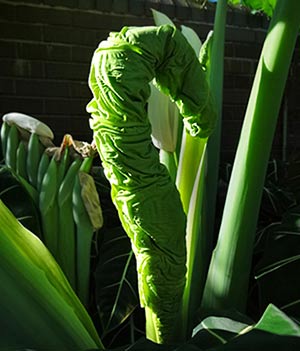 A just born leaf on a giant elephant ear plant in the Kemper Gardens.
A just born leaf on a giant elephant ear plant in the Kemper Gardens.
Late Summer Treats
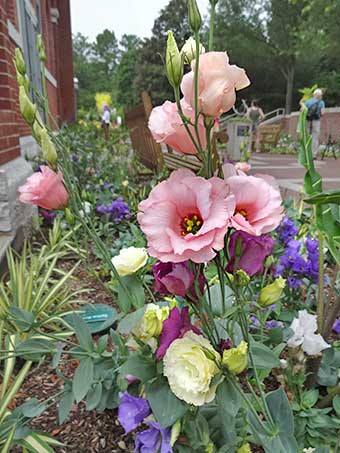 This year, the botanical garden features several beds of Lisianthus in the display plots that most visitors pass. The beds of Lisianthus are a mix of purple, gold, white, apricot, and blue. Nothing garish here – Lizzy’s are bred to come in eye-pleasing tints. At a glace they could even be mistaken for peonies, roses, or tulips. I read in Amy Steward’s Flower Confidential that because Lisianthus are cheaper and easier to grow than roses, they’re a favorite of florists who like pair them with roses to make larger, more extravagant looking bouquets for less money. They’re also desirable because they can last for 10 – 15 days and because they don’t have a fragrance, they never call attention to themselves.
This year, the botanical garden features several beds of Lisianthus in the display plots that most visitors pass. The beds of Lisianthus are a mix of purple, gold, white, apricot, and blue. Nothing garish here – Lizzy’s are bred to come in eye-pleasing tints. At a glace they could even be mistaken for peonies, roses, or tulips. I read in Amy Steward’s Flower Confidential that because Lisianthus are cheaper and easier to grow than roses, they’re a favorite of florists who like pair them with roses to make larger, more extravagant looking bouquets for less money. They’re also desirable because they can last for 10 – 15 days and because they don’t have a fragrance, they never call attention to themselves.
Lisianthis flowers are in their element when they’re wrapped in cellophane in a supermarket or included in a wedding bouquet. But when I see them growing outdoors, they seem wrong. Lizzy’s, despite their roots as wildflowers, are indoor plants meant to start their lives in greenhouses and finish them as cut flowers. They seem out of place growing outside. I look at them and think that if they were pets instead of a flowers, they’d be whimpering as they pawed at the door begging to be let in.
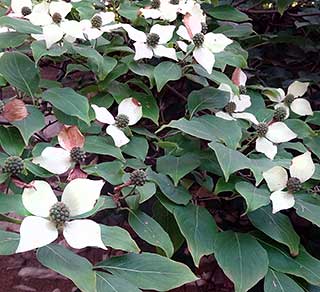 I wasn’t expecting to see a dogwood still in flower. Along the stone wall just behind the daylilies beds I saw this Kousa dogwood filled with a fair number of its toothy four-petalled white blooms. The Kousa blooms in late May after the spring blooming dogwoods have faded. So not only do they get to the party late, they seem to be the last to leave.
I wasn’t expecting to see a dogwood still in flower. Along the stone wall just behind the daylilies beds I saw this Kousa dogwood filled with a fair number of its toothy four-petalled white blooms. The Kousa blooms in late May after the spring blooming dogwoods have faded. So not only do they get to the party late, they seem to be the last to leave.
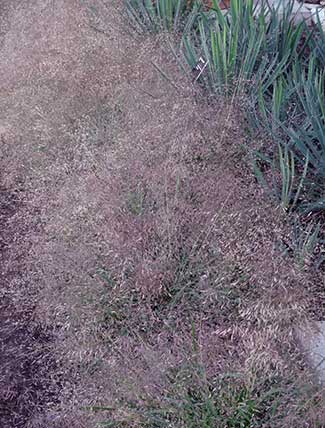 The Purple Love Grass (Eragrostis spectabilis) outside the front entrance to the Linnean House is doing as promised. When I last looked at it in early May it was a scattering of tough-looking green clumps. Now the clumps have expanded, but they’re completely hidden by countless sprays filled with tiny vaguely purple flowers that from a distance seem to join up to form a ground hugging cloud. There’s not a lot of Love Grass planted here so the effect is muted, but have a look at this picture taken by Bob Cunningham of a stand of love grass growing wild in New Jersey.
The Purple Love Grass (Eragrostis spectabilis) outside the front entrance to the Linnean House is doing as promised. When I last looked at it in early May it was a scattering of tough-looking green clumps. Now the clumps have expanded, but they’re completely hidden by countless sprays filled with tiny vaguely purple flowers that from a distance seem to join up to form a ground hugging cloud. There’s not a lot of Love Grass planted here so the effect is muted, but have a look at this picture taken by Bob Cunningham of a stand of love grass growing wild in New Jersey.
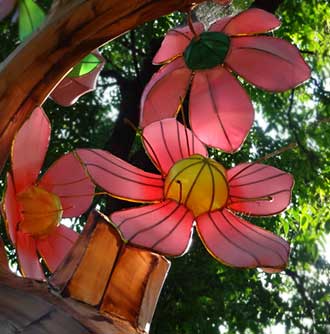 The sun is at just the right angle this morning to back light some the installations constructed for the Chinese Lantern Festival. At night the sets are lit from bulbs inside the displays so that every detail of the set is fully and evenly lit. This morning though the light from the rising sun is caught by fabric and passed through it unevenly creating light and shadows.
The sun is at just the right angle this morning to back light some the installations constructed for the Chinese Lantern Festival. At night the sets are lit from bulbs inside the displays so that every detail of the set is fully and evenly lit. This morning though the light from the rising sun is caught by fabric and passed through it unevenly creating light and shadows.
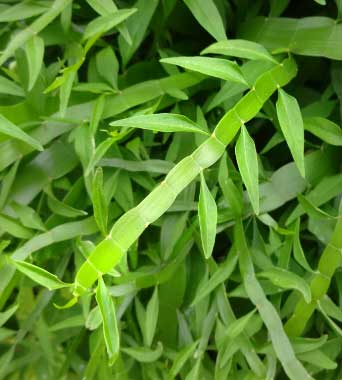 Years ago in the comic section of our local newspaper there was a panel named “Our Own Oddies.” It was the first thing, sometimes the only thing, I read in comic section. It featured unusual, often strange, sometimes bizarre things that newspaper readers submitted to the illustrator Ralph Grazek who drew the panel. Many of the illustrations featured plants and vegetables: a squash shaped like a duck, a cantaloupe elongated to resemble an avocado, a potato that looked like a spitting cobra, a tree shaped like the number four, and a sunflower with a seedpod that bulged out to form a cone. Here’s a plant at the botanical garden that I think would make the paper. It’s formal name is Homalocladium platycladum. Informally though it’s called a centipede plant, a tapeworm plant, or a ribbon bush. The plants are sandwiched in among the lantanas at the edges of the ponds on the garden’s central axis. They’re tender tropicals so they’ve been planted solely for us to point at and smile about during the summer. I’m glad they’re here.
Years ago in the comic section of our local newspaper there was a panel named “Our Own Oddies.” It was the first thing, sometimes the only thing, I read in comic section. It featured unusual, often strange, sometimes bizarre things that newspaper readers submitted to the illustrator Ralph Grazek who drew the panel. Many of the illustrations featured plants and vegetables: a squash shaped like a duck, a cantaloupe elongated to resemble an avocado, a potato that looked like a spitting cobra, a tree shaped like the number four, and a sunflower with a seedpod that bulged out to form a cone. Here’s a plant at the botanical garden that I think would make the paper. It’s formal name is Homalocladium platycladum. Informally though it’s called a centipede plant, a tapeworm plant, or a ribbon bush. The plants are sandwiched in among the lantanas at the edges of the ponds on the garden’s central axis. They’re tender tropicals so they’ve been planted solely for us to point at and smile about during the summer. I’m glad they’re here.
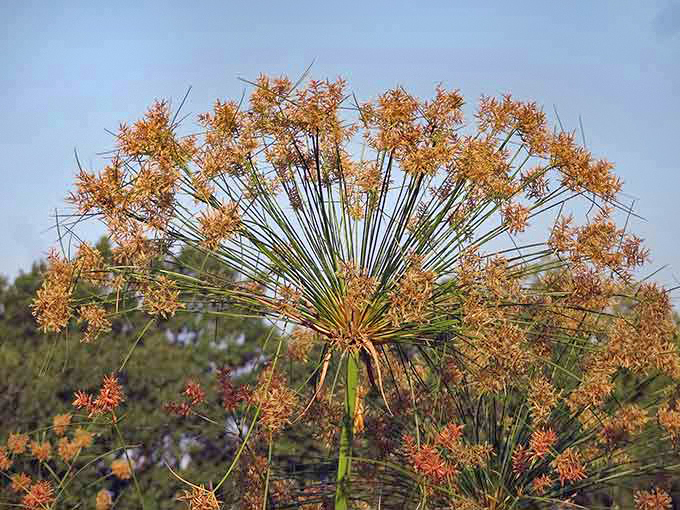 The display gardens around the ponds outside the Linnean House are brimming with papyrus plants (Cyperus papyrus KING TUT). This is a rare chance for visitors to see the plants close-up. The plants are as tall as they can get (4 to 5 feet) and they’re topped with a spray of flowers and seeds on top. Since many of them are growing so close to the walkways, I like to run my fingers along their unusual triangular-shaped stems.
The display gardens around the ponds outside the Linnean House are brimming with papyrus plants (Cyperus papyrus KING TUT). This is a rare chance for visitors to see the plants close-up. The plants are as tall as they can get (4 to 5 feet) and they’re topped with a spray of flowers and seeds on top. Since many of them are growing so close to the walkways, I like to run my fingers along their unusual triangular-shaped stems.
The Odd, the Strange, and the Unpredictable
Most flowering plants behave predictably. If it’s April, tulips start to bloom. Come September the mums are in full flower. More interesting through are the plants and flowers that bloom according to their own internal calendar. They bloom when they’re ready. But only they know when that is.
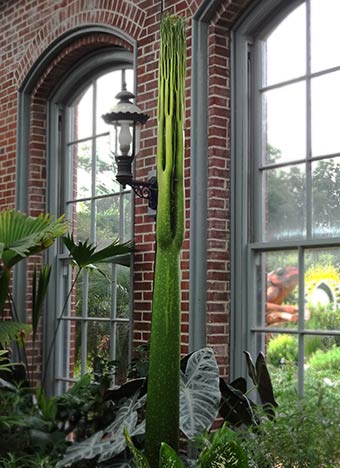 Right now in the Botanical Garden’s Linnean glasshouse there’s one of these independent plants behaving as it wills. This morning the Titan or Corpse Flower (Amorphophallus titanium) is on the verge of spreading its huge umbrella canopy. While watching a leaf unfurl may be interesting to some, it’s not the leaf that draws the crowds or the press coverage -- it’s the plant's Audrey II-sized exotic flower that smells like an open sewer that packs the house.
Right now in the Botanical Garden’s Linnean glasshouse there’s one of these independent plants behaving as it wills. This morning the Titan or Corpse Flower (Amorphophallus titanium) is on the verge of spreading its huge umbrella canopy. While watching a leaf unfurl may be interesting to some, it’s not the leaf that draws the crowds or the press coverage -- it’s the plant's Audrey II-sized exotic flower that smells like an open sewer that packs the house.
This Titan is producing a canopy, but no flower. Like a volcano, the Titan doesn’t erupt into a flower until it has stored enough energy in its exercise-ball sized underground stem that biologists call a “corm.” How long does it take? That’s where the unpredictability comes in – maybe a few years; maybe a decade or more; maybe never. A Corpse Flower named ‘Izzy’ bloomed here last July. I’m wondering if this is Izzy regaining its strength so that it can flower again.
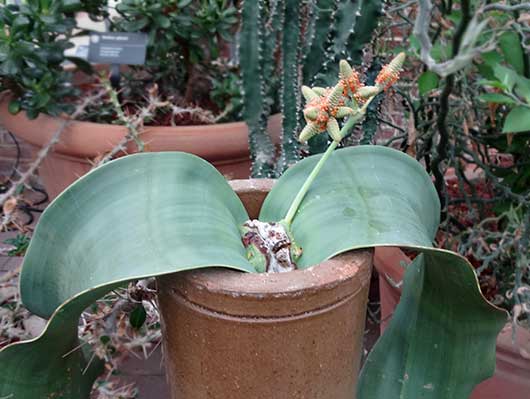 Just down the walkway from the Corpse Flower is this plant. The Welwitschia mirabilis is growing out out of the top of a two-foot long drain tile. In Namibia, where the plant comes from, it sends a long tap root deep into the desert sand and then spreads its lateral roots from the tap for 15 feet in all directions. The sign alongside the Welwitschia growing here says the plant can live for 1500 years, but in its long lifetime it only produces these two wide strap-like leaves.
Just down the walkway from the Corpse Flower is this plant. The Welwitschia mirabilis is growing out out of the top of a two-foot long drain tile. In Namibia, where the plant comes from, it sends a long tap root deep into the desert sand and then spreads its lateral roots from the tap for 15 feet in all directions. The sign alongside the Welwitschia growing here says the plant can live for 1500 years, but in its long lifetime it only produces these two wide strap-like leaves.
![By Thomas Schoch [GFDL (http://www.gnu.org/copyleft/fdl.html) or CC BY-SA 3.0 (http://creativecommons.org/licenses/by-sa/3.0)], via Wikimedia Commons](images/080815Welwitschia_in_namibia.jpg) The plant growing here is a young one. Mature ones like ones growing in the Namibian desert can have leaves up to 13 feet long that swivel and curl up on themselves. I’ve seen web sites that describe the mature Welwitschia as the world’s ugliest plant, or a giant dehydrated octopus, or a very, very bad hair day.
The plant growing here is a young one. Mature ones like ones growing in the Namibian desert can have leaves up to 13 feet long that swivel and curl up on themselves. I’ve seen web sites that describe the mature Welwitschia as the world’s ugliest plant, or a giant dehydrated octopus, or a very, very bad hair day.
Like the corpse flower, the Welwitschia’s attracts visitors who want see it and pose alongside it. There are nearly a dozen tour operators in Namibia who offer desert excursions to see the Welwitchias. And maybe because of the plant’s value as a tourist attraction, the government has named it as the nation’s national flower and features it prominently on country’s tourist website.
This morning the young Welwitschia at the botanical garden is in flower. Botanists would put quotes around the word "flower" because what looks to us like a flower is really something less to them because Welwitschias, like pines and cycads produce cones, not flowers.
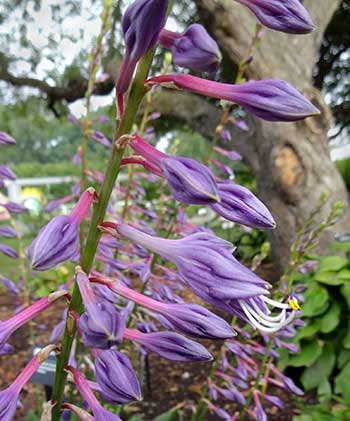 This must be the day of the strange. At the edge of the large beds of hosta cultivars, there’s a small bed of about 20 hosta specie plants clustered around the base of a flowering crab tree. This one called Hosta clausa was the one I wanted to see. I saw a clump of them growing alongside the stream in the Chinese Garden about three years ago. There was no sign to identity the hostas there but I couldn’t help but notice the color of their buds that begin with fuchsia at their bases and then blend into rich purple at their tips. It’s a striking color combination unusual among hostas. But there’s more. Mark Zilis’ The Hosta Handbook says that these hosta buds will never flower. They will remain closed just as they are today until they begin to drop and fall off. Zilis writes that “even if the flowers are artificially opened and pollinated, they do not form seeds.” Zillis calls the flowering habits “unusual and intriguing” but doesn’t speculate about the more fascinating question of why this hosta even bothers to form fully functioning flowers that never open and never reproduce. The plant I saw this morning did have one partially opened flower which proves the rule, I suppose.
This must be the day of the strange. At the edge of the large beds of hosta cultivars, there’s a small bed of about 20 hosta specie plants clustered around the base of a flowering crab tree. This one called Hosta clausa was the one I wanted to see. I saw a clump of them growing alongside the stream in the Chinese Garden about three years ago. There was no sign to identity the hostas there but I couldn’t help but notice the color of their buds that begin with fuchsia at their bases and then blend into rich purple at their tips. It’s a striking color combination unusual among hostas. But there’s more. Mark Zilis’ The Hosta Handbook says that these hosta buds will never flower. They will remain closed just as they are today until they begin to drop and fall off. Zilis writes that “even if the flowers are artificially opened and pollinated, they do not form seeds.” Zillis calls the flowering habits “unusual and intriguing” but doesn’t speculate about the more fascinating question of why this hosta even bothers to form fully functioning flowers that never open and never reproduce. The plant I saw this morning did have one partially opened flower which proves the rule, I suppose.
 I wonder? Do hosta fanciers ever tire of having or seeing the next spectacular hosta – one that’s bigger or tinier or frostier or more variegated or filled with more purple markings? I never do. I am continually fascinated by the next best cultivar. But as the season wears on and the flashier hostas begin to tater and fade , I start to look more carefully at hostas with nothing to offer but rich green, normal-sized simple graceful leaves – nothing wavy or corrugated, please. This hosta specie named longissima fits the bill. Hosta observers call it the Swamp Hosta because it’s one of few hostas that can grow directly in water. It’s also a late bloomer so it will start to flower after the competition is gone.
I wonder? Do hosta fanciers ever tire of having or seeing the next spectacular hosta – one that’s bigger or tinier or frostier or more variegated or filled with more purple markings? I never do. I am continually fascinated by the next best cultivar. But as the season wears on and the flashier hostas begin to tater and fade , I start to look more carefully at hostas with nothing to offer but rich green, normal-sized simple graceful leaves – nothing wavy or corrugated, please. This hosta specie named longissima fits the bill. Hosta observers call it the Swamp Hosta because it’s one of few hostas that can grow directly in water. It’s also a late bloomer so it will start to flower after the competition is gone.
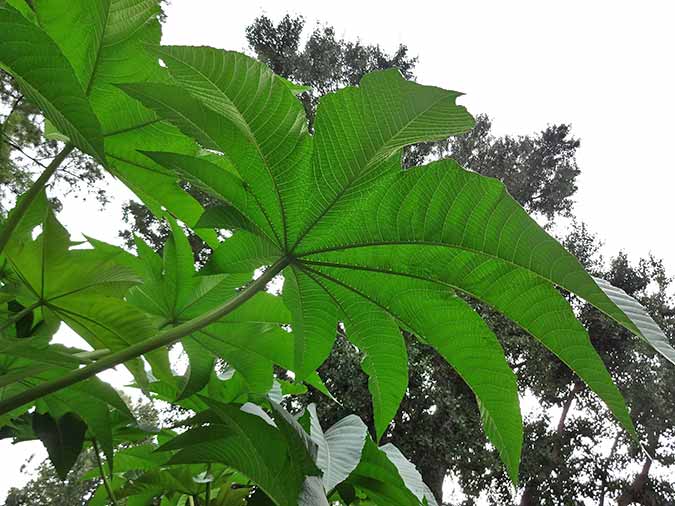 Summer in this botanical garden is known for its waterlilies – especially the giant Victoria pads that have been display here for more than 100 years. Usually the largest of the three reflecting ponds in the Garden’s central axis is filled with six lilies – two each of the species waterlily Victoria amazonica and Victoria cruziana and two of the hybrid ‘Longwood.’ This year there are none because the display ponds are filled with installations that are part of the Chinese Lantern Festival. But as if to make up for the loss of the waterlilies, the garden keepers have planted long rows of tall castor bean plants (Ricinus communis) along the walkways that frame the ponds. Their giant leaves with their strong ribbed under-surfaces make them look a bit like I imagine a land-loving Victoria would look.
Summer in this botanical garden is known for its waterlilies – especially the giant Victoria pads that have been display here for more than 100 years. Usually the largest of the three reflecting ponds in the Garden’s central axis is filled with six lilies – two each of the species waterlily Victoria amazonica and Victoria cruziana and two of the hybrid ‘Longwood.’ This year there are none because the display ponds are filled with installations that are part of the Chinese Lantern Festival. But as if to make up for the loss of the waterlilies, the garden keepers have planted long rows of tall castor bean plants (Ricinus communis) along the walkways that frame the ponds. Their giant leaves with their strong ribbed under-surfaces make them look a bit like I imagine a land-loving Victoria would look.
 Squirrels are doing their best to strip the fruit and nut trees. The pear trees in the Ottoman Garden are bare. The seeds on the mature hornbeams trees are gone. Now the hickory, pecans, and even the tough black walnuts are being stripped of their flesh.
Squirrels are doing their best to strip the fruit and nut trees. The pear trees in the Ottoman Garden are bare. The seeds on the mature hornbeams trees are gone. Now the hickory, pecans, and even the tough black walnuts are being stripped of their flesh.
